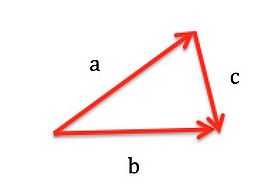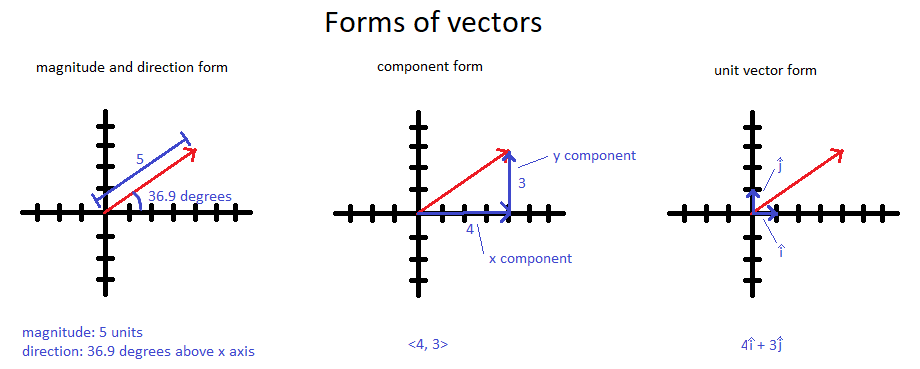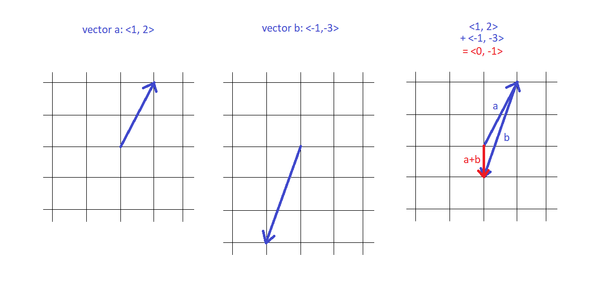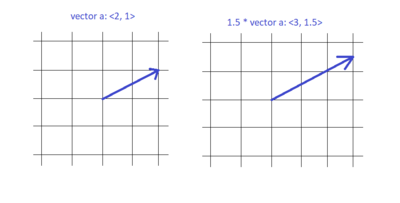Vectors: Difference between revisions
No edit summary |
|||
| Line 137: | Line 137: | ||
To graphically represent a vector such as an electric field, "arrow" objects should be used. In addition to taking a position vector (which determines the position of the arrow's tail), arrow objects take an "axis" vector, which determines their size and shape. To represent a vector, simply make it the axis of an arrow object. | To graphically represent a vector such as an electric field, "arrow" objects should be used. In addition to taking a position vector (which determines the position of the arrow's tail), arrow objects take an "axis" vector, which determines their size and shape. To represent a vector, simply make it the axis of an arrow object. | ||
==Examples== | ==Examples== | ||
===Simple=== | ===Simple=== | ||
Revision as of 12:34, 28 July 2019
This page defines and describes vectors.
The Main Idea
In mathematics and physics, a vector is a quantity with both a magnitude and a direction in space. The magnitude of a vector is a scalar value which can represent a variety of characteristics, depending on the situation. The magnitude of the vector (and the vector itself) has units corresponding to the characteristic it represents. The direction of a vector is simply an orientation in space giving context to the magnitude. Note that a vector does not necessarily extend from one point in real, physical space to another; unless the magnitude is in units of length, the magnitude of the vector usually represents a property that exists at a single point in real, physical space, or at no position in particular.
Simple Examples of Vector Quantities
To understand what it means for a vector to have both a magnitude and a direction, and to understand why the magnitude and direction together are often considered a single quantity, it can be helpful to consider an example. The Velocity of an object is an example of a vector quantity. The speed of the object, often given in meters per second (m/s), is a scalar value describing how quickly the object is moving. Speed is the magnitude of the velocity vector. However, the object's movement happens in a particular spatial direction, which the speed alone does not tell us. The direction of the object's movement is also a part of the velocity vector. Together, speed and direction comprise the velocity vector and give a complete description of an object's motion at a point in time. Another example of a vector is position; the distance of a point from the origin of a coordinate system can be represented as the magnitude of a vector, and this distance together with a direction describes exactly where a point can be found.
Unit Vectors
A unit vector is a vector whose magnitude is 1 by design.
Some unit vectors are normalized regular vectors. For example, [math]\displaystyle{ \hat{r} }[/math] is the normalized version of some vector [math]\displaystyle{ \vec{r} }[/math]. Normalization is the process of setting a vector's magnitude to 1. This is done to discard information about the vector's magnitude while retaining information about its direction. To normalize a vector, the following formula can be used: [math]\displaystyle{ \hat{a} = \frac{\vec{a}}{|\vec{a}|} }[/math]
Certain letters represent specific unit vectors. For example, [math]\displaystyle{ \hat{i} }[/math], [math]\displaystyle{ \hat{j} }[/math], and [math]\displaystyle{ \hat{k} }[/math] (alternatively, [math]\displaystyle{ \hat{x} }[/math], [math]\displaystyle{ \hat{y} }[/math], and [math]\displaystyle{ \hat{z} }[/math]) are unit vectors pointing in the +x, +y, and +z directions respectively. Non-Cartesian coordinate systems often have their own unit vectors; for example, 2D polar coordinates make use of the [math]\displaystyle{ \hat{r} }[/math] and [math]\displaystyle{ \hat{\theta} }[/math] unit vectors.
Notation
A variable representing a vector is typically written as a letter with an arrow over it: [math]\displaystyle{ \vec{a} }[/math]. The arrow may one-sided to make it easier to write. Alternatively, a vector variable might simply be written as a boldface letter: a. Which letter is used depends on the context; for example, [math]\displaystyle{ \vec{v} }[/math] represents velocity.
Surrounding a vector by | symbols denotes its magnitude: [math]\displaystyle{ |\vec{b}| }[/math].
A specific component of a vector (see the section titled "forms") is denoted by a subscript: cx. For example, qy represents the y component of some vector [math]\displaystyle{ \vec{q} }[/math].
A unit vector is denoted by a letter with a ^ symbol (called a "hat") written over it: [math]\displaystyle{ \hat{d} }[/math] (read as "d-hat").
Visually Representing Vectors
Vectors are visually represented by arrows. The length of the arrow represents the magnitude of the vector, while the direction the arrow points in represents the direction of the vector. If a vector exists at a particular point in space, the "tail" of the arrow (the end without the V shape) should be placed at that point.
This example shows a visual representation of the velocity vector of a ball, which is moving to the right at a speed of 5m/s.
Forms
The information necessary to describe a specific vector can be presented in several forms.
Magnitude and direction form
In this form, the magnitude and the direction of the vector are explicitly stated. The statement describing direction might be a cardinal direction (ex. "north"), a direction on a graph (ex. "the +x direction"), or an angle (ex. "210[math]\displaystyle{ ^\circ }[/math] from the x axis counterclockwise"), depending on the situation. Magnitude and direction form is often used in word problems because it is easy for humans to understand.
Component form
In this form, the vector is divided into components, each representing a different coordinate direction. In 2D space, these are the x and y directions. In 3D space, these are the x, y, and z directions. Each component tells how much the vector extends in that particular direction. Often, the three components are written enclosed by angle brackets and separated by commas. For example, the vector <2,0,-3> describes a vector that extends 2 units in the +x direction, 0 units in the y direction, and 3 units in the -z direction. Most vector operations described below can only be performed if the vectors are in component form, so this form may be necessary to do math for certain problems. Furthermore, programming languages store vectors in component form.
Unit vector form
In this form, the vector is expressed as a sum of unit vectors, each corresponding to a different coordinate direction. The symbols [math]\displaystyle{ \hat{i} }[/math], [math]\displaystyle{ \hat{j} }[/math], and [math]\displaystyle{ \hat{k} }[/math] OR the symbols [math]\displaystyle{ \hat{x} }[/math], [math]\displaystyle{ \hat{y} }[/math], and [math]\displaystyle{ \hat{z} }[/math] are used to represent unit vectors in the x, y, and z directions respectively. Consider the vector <2,0,-3>. It can be expressed in unit vector form as [math]\displaystyle{ 2\hat{i} - 3\hat{k} }[/math], meaning 2 times the x direction unit vector minus 3 times the z direction unit vector (see vector operations). While often considered its own form, unit vector form is very similar to component form, as the information describing the vector is stored in the same values. All references to component form in the rest of this page also apply to unit vector form.
Note that regardless of which form is used, an n dimensional vector requires n values to mathematically describe. For example, consider a 3-dimensional vector. Describing this vector in component form requires an x value, a y value, and a z value. Describing it in magnitude and direction form requires one value to give the magnitude of the vector and two to give the its direction (the direction of a 3D vector could be described using, say, its polar angle [math]\displaystyle{ \theta }[/math] and its azimuthal angle [math]\displaystyle{ \phi }[/math]).
Converting between forms
It is possible to convert vectors from one form to another using simple trigonometry.
To find the magnitude of a vector in component form, use the Pythagorean theorem: add the squares of the components and take the square root of the result. For a 2D vector, [math]\displaystyle{ |\vec{a}| = \sqrt{a_x^2 + a_y^2} }[/math].
To find the direction of a vector in component form, use inverse trigonometric functions. For a 2D vector, [math]\displaystyle{ \theta = \tan^{-1}(\frac{a_y}{a_x}) }[/math], where [math]\displaystyle{ \theta }[/math] is the angle vector [math]\displaystyle{ \vec{a} }[/math] makes with the x axis in the counterclockwise direction.
To find the components of a vector in magnitude and direction form, use trigonometric functions. For a 2D vector, [math]\displaystyle{ a_x = |\vec{a}|\cos\theta }[/math] and [math]\displaystyle{ a_y = |\vec{a}|\sin\theta }[/math], where [math]\displaystyle{ \theta }[/math] is the angle vector [math]\displaystyle{ \vec{a} }[/math] makes with the x axis in the counterclockwise direction.
Vector Operations
It is possible to perform a variety of mathematical operations on vectors, both with other vectors and with scalars. These operations appear in a variety of formulas in physics. To make the operations easier to learn, they are defined below assuming all vectors to be 3-dimensional; the more general n-dimensional definitions look more confusing. If necessary, it is easy to guess how to perform each operation with n-dimensional vectors by extrapolating from the 3-dimensional case.
Addition:
[math]\displaystyle{ \vec{a} + \vec{b} = (a_x + b_x)\hat{i} + (a_y + b_y)\hat{j} + (a_z + b_z)\hat{k} }[/math].
In other words, to add two vectors, simply add their like components to form the new components. The new vector is called the resultant of the other two. Visually, if the tail of one vector is placed at the tip of another, their resultant will extend from the tail of the second vector to the tip of the first:
Subtraction:
[math]\displaystyle{ \vec{a} - \vec{b} = (a_x - b_x)\hat{i} + (a_y - b_y)\hat{j} + (a_z - b_z)\hat{k} }[/math].
In other words, to subtract two vectors, simply subtract their like components to form the new components.
Multiplication by scalar:
[math]\displaystyle{ k \vec{a} = ka_x\hat{i} + ka_y\hat{j} + ka_z\hat{k} }[/math].
In other words, multiplying a vector by a scalar multiplies each of that vector's components by that scalar. Multiplying a vector by a scalar multiplies its magnitude by that scalar and does not affect its direction, unless the scalar is negative, in which case the direction of the vector is reversed.
Division by scalar:
[math]\displaystyle{ \frac{\vec{a}}{k} = \frac{a_x}{k}\hat{i} + \frac{a_y}{k}\hat{j} + \frac{a_z}{k}\hat{k} }[/math].
In other words, dividing a vector by a scalar divides each of that vector's components by that scalar. Dividing a vector by a scalar divides its magnitude by that scalar and does not affect its direction, unless the scalar is negative, in which case the direction of the vector is reversed.
Dot product (also called scalar product):
[math]\displaystyle{ \vec{a}\cdot\vec{b} = a_xb_x + a_yb_y + a_zb_z }[/math].
In other words, the dot product of two vectors is the sum of the products of their like components. Note that this is a scalar value.
It is important to note that the dot product of two vectors has a specific value: [math]\displaystyle{ \vec{a}\cdot\vec{b} = |\vec{a}||\vec{b}|\cos\theta }[/math], where [math]\displaystyle{ \theta }[/math] is the angle between the vectors.
Cross product (also called vector product):
[math]\displaystyle{ \vec{a}\times\vec{b} = (a_yb_z - a_zb_y)\hat{i} + (a_zb_x - a_xb_z)\hat{j} + (a_xb_y - a_yb_x)\hat{k} }[/math].
This is equivalent to the following matrix determinant, which may be easier to remember:
[math]\displaystyle{ \begin{vmatrix} \hat{i} & \hat{j} & \hat{k} \\ a_x & a_y & a_z \\ b_x & b_y & b_z \end{vmatrix} }[/math]
Note that this is a vector quantity. It is important to note that the magnitude of the cross product of two vectors has a specific value: [math]\displaystyle{ |\vec{a}\times\vec{b}| = |\vec{a}||\vec{b}|\sin\theta }[/math], where [math]\displaystyle{ \theta }[/math] is the angle between the vectors. The direction of the cross product of two vectors is perpendicular to the plane in which those vectors lie and is given by the Right Hand Rule. 2D vectors do not have cross products. While the other operations listed here are commutative, associative (where the associative property is defined), and distributive over addition; cross product multiplication is not associative and is anticommutative ([math]\displaystyle{ \vec{a}\times\vec{b} = -\vec{b}\times\vec{a} }[/math]), meaning that if the order of the factors is reversed, their cross product will be reversed in direction.
Transformations
A variety of transformations are defined for vectors, including multiplication by matrices and projection onto spaces. These transformations use a combination of the six basic operations above to manipulate vectors in more complex ways. These transformations lie outside of the scope of this page and this course due to their complexity and irrelevance to introductory physics.
A Computational Model
In VPython, vector objects are in component form; each one has an x, y, and z component. Recall that in VPython, using the default camera orientation, the +x axis points to the right, the +y axis points upwards, and the +z axis points out of the plane of the screen towards the viewer. The constructor for a vector object is the word "vec" or "vector," and it takes three arguments, which define its x, y and z components respectively. A line to create a vector called "velocity" might look like this:
velocity = vec(3,-1,2)
To access or modify a specific component of a vector object, its name should be followed by a period and an x, y, or z. For example, to change the x component of the above velocity vector from 3 to 5, the following line might be used:
velocity.x = 5
In VPython, vectors have many uses. The position of each object is defined as a vector; the position vector's tail lies at the origin and its head lies at the center of the object in question. Furthermore, the dimensions of a rectangular prism (a "box" object) are defined as a vector; the x component determines its width, the y component its height, and the z component its thickness.
To graphically represent a vector such as an electric field, "arrow" objects should be used. In addition to taking a position vector (which determines the position of the arrow's tail), arrow objects take an "axis" vector, which determines their size and shape. To represent a vector, simply make it the axis of an arrow object.
Examples
Simple
Which of the following statements is correct? (Can be more than one)

1. [math]\displaystyle{ \overrightarrow{c} = \overrightarrow{a} + \overrightarrow{b} }[/math]
2. [math]\displaystyle{ \overrightarrow{a} = \overrightarrow{b} - \overrightarrow{c} }[/math]
3. [math]\displaystyle{ \overrightarrow{a} = \overrightarrow{c} + \overrightarrow{b} }[/math]
4. [math]\displaystyle{ \overrightarrow{b} = \overrightarrow{c} + \overrightarrow{a} }[/math]
The answer is option number 2 and option number 4.
Intermediate
1. What is the magnitude of the vector C = A - B if A = <10, 5, 8> and B = <9, 4, 3>?
First we need to find the vector C: A - B = [math]\displaystyle{ \lt (10-9), (5-4), (8-3)\gt = \lt 1, 1, 5\gt = C }[/math]
[math]\displaystyle{ \sqrt{(1)^2 + 1^2 + 5^2} = 5.196 }[/math]
2. What is the cross product of A = <1,2,3> and B = <9,4,5>?
Use the equation for cross product: a x b= <a1, a2, a3> x <b1, b2, b3> = <a2*b3 - a3*b2> i - <a1*b3 - a3*b1> j + <a1*b2 - a2*b1> k
A x B[math]\displaystyle{ =\lt 2*5 - 3*4, 1*5 - 3*9, 1*4 - 2*9\gt = \lt -2, -22, -14\gt }[/math]
Difficult
What is the angle between the vectors <2,5,-2> and <3,-4,-1>?
Solution:
The dot product between two vectors is equal to the product of their magnitudes times the cosine of the angle between them. Let us use this property to find the angle between the given vectors.
[math]\displaystyle{ \lt 2,5,-2\gt \cdot \lt 3,-4,-1\gt = |\lt 2,5,-2\gt | * |\lt 3,-4,-1\gt | * \cos\theta }[/math]
[math]\displaystyle{ \theta = \cos^{-1}\frac{\lt 2,5,-2\gt \cdot \lt 3,-4,-1\gt }{|\lt 2,5,-2\gt | * |\lt 3,-4,-1\gt |} }[/math]
[math]\displaystyle{ \theta = \cos^{-1}\frac{2(3) + 5(-4) + (-2)(-1)}{\sqrt{2^2 + 5^2 + (-2)^2} * \sqrt{3^2 + (-4)^2 + (-1)^2}} }[/math]
[math]\displaystyle{ \theta = \cos^{-1}\frac{-12}{\sqrt{33 * 26}} }[/math]
[math]\displaystyle{ \theta = 114^\circ }[/math]
Connectedness
1.Vectors will be used in many applications in most calculation based fields when movement and position are involved. Vectors can be two dimensional or three dimensional. Vectors are used to represent forces, fields, and momentum.
2.Vectors has been used in many application problems in engineering majors. In engineering applications, vectors are used to a lot of quantities which have both magnitude and direction. Dividing a magnitude into vector quantities in the x,y, and z directions clarify which components of a vector have quantity. For example, in Biomedical Engineering applications, vectors are used to represent the velocity of a flow to further calculate the flow rate and some other related quantities.
3. Vectors play a huge part in industry. For example, in process flow, vectors play a huge part in most calculations. For example, many calculations in different fields of science and math use vector components and direction. Our car's GPS uses vectors even if we don't realize it!
History
The discovery and use of vectors can date back to the ancient philosophers, Aristotle and Heron. The theory can also be found in the first article of Newtons Principia Mathematica. In the early 19th century Caspar Wessel, Jean Robert Argand, Carl Friedrich Gauss, and a few more depicted and worked with complex numbers as points on a 2D plane. in 1827, August Ferdinand published a book introducing line segments labelled with letters. he wrote about vectors without the name "vector".
In 1835, Giusto Bellavitis abstracted the basic idea of a vector while establishing the concept of equipollence. He called any pair of line segments of the same length and orientation equipollent (meaning equal length). He found a relationship and created the first set of vectors. Also in 1835 Hamilton founded "quaternions", which were 4D planes and equations with vectors.
William Rowan Hamilton devised the name "vector" as part of his system of quaternions consisting of three dimensional vectors.
Several other mathematicians developed similar vector systems to those of Bellavitis and Hamilton in the 19th century. The system used by Herman Grassman is the one that is most similar to the one used today.
VPython was released by David Scherer in the year 2000. He came up with the idea after taking a physics class at Carnegie Mellon University. Previous programs only allowed for 2D modeling, so he took it upon himself to make something better. VPython, also known as Visual Python, allows for 3D modeling.
See also
External links
Mathematical Computations on Vectors: [1]
Computational Work with Vectors: [2]
Basics of Vectors: [3]
Further Reading
Vector Analysis by Josiah Willard Gibbs
Introduction to Matrices and Vectors by Jacob T. Schwartz



